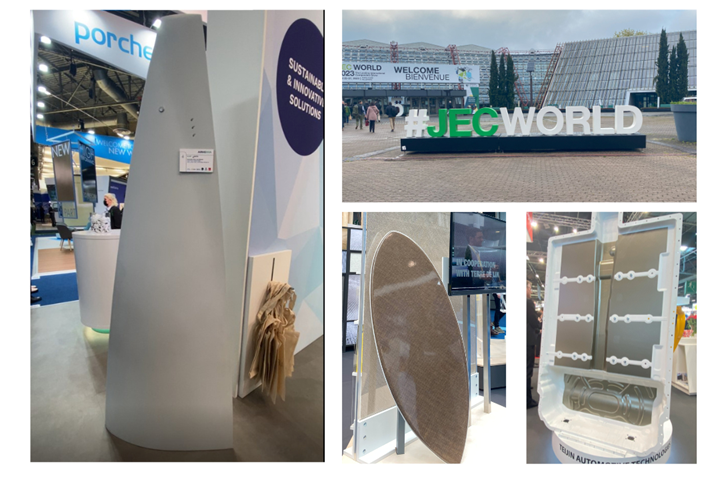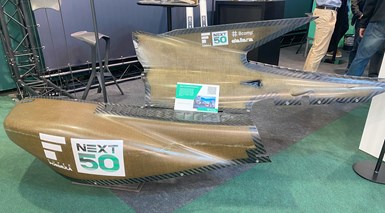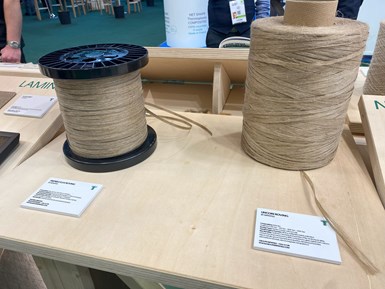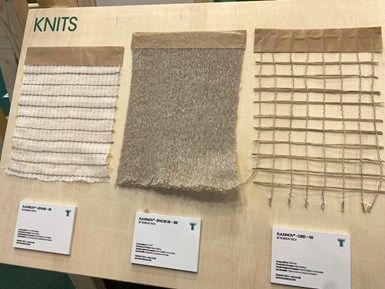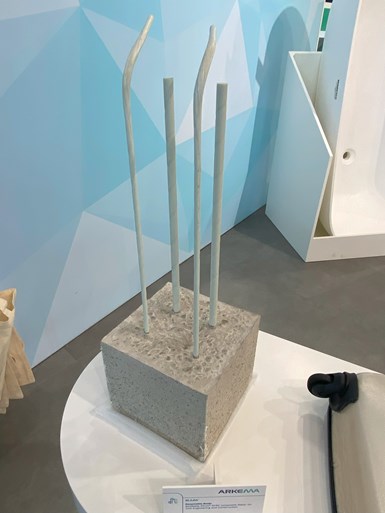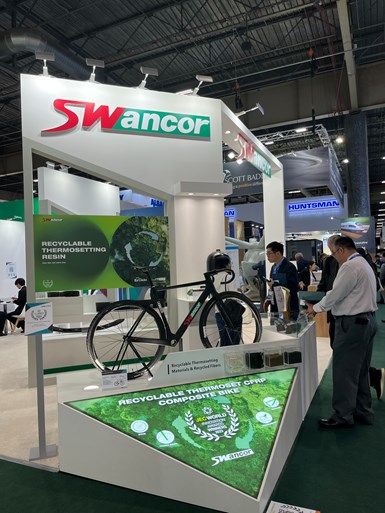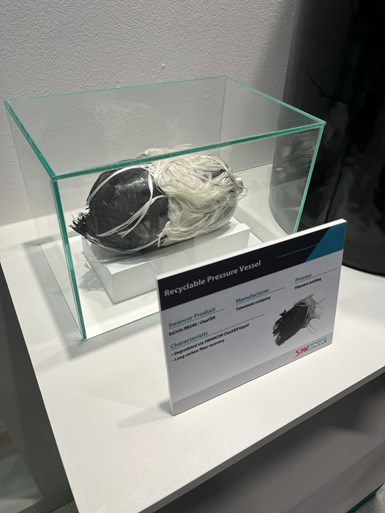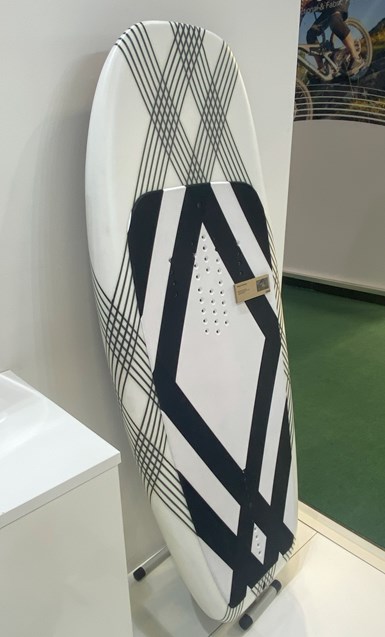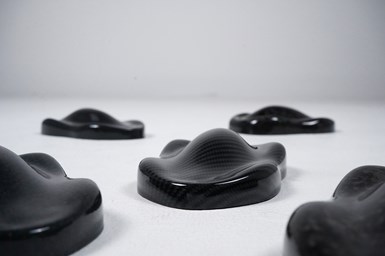JEC World 2023 highlights: Recyclable resins, renewable energy solutions, award-winning automotive
CW technical editor Hannah Mason recaps some of the technology on display at JEC World, including natural, bio-based or recyclable materials solutions, innovative automotive and renewable energy components and more.
Share
JEC World 2023 showcased new materials, technologies and solutions for the composites industry, many of them centered on sustainability in various ways. Pictured are a model wind turbine blade made with recyclable Arkema Elium resin as part of the ZEBRA project (far left), a flax fiber surfboard demonstrating natural fiber offerings from Saertex (bottom middle) and battery enclosures for electric vehicles (EV) on display by Teijin Automotive (bottom right). Photo Credit: CW
At JEC World 2023 (Paris France, April 25-27, 2023), sustainability continued to be the top trend, featuring many solutions using natural and recycled fibers, recyclable or bio-based resins, recycling technologies, new innovations to enable wind or other renewable energy applications and more. Many companies also used the show as a chance to display new capabilities and growth into new or emerging markets.
Below are a few highlights from my visit to the show. See CW senior editor Ginger Gardiner’s JEC 2023 highlights for more on new recycling companies, biocomposites and more. The CW team will also be publishing additional JEC highlights and video footage in the coming weeks on its Youtube channel, and associated social channels.
Growing presence of natural fibers
Like last year, JEC World 2023 featured a dedicated — and, this year, expanded — Natural Fibers Village area featuring more than a dozen suppliers of natural fiber products.
A variety of natural fiber composite parts and materials were on display at JEC World’s Natural Fibers Village. Pictured are the Super Formula body panels displayed by Bcomp (top image), rovings from Depestele (middle) and knit fabrics from Texinov Tech (bottom). Photo Credit: CW
Many of the companies in this area were members of hosting organization the Alliance for European Flax-Linen and Hemp (Paris, France). Through its thousands of members across the European natural fiber value chain, the Alliance helps to validate and ensure consistency of natural fibers for use in various markets, including composites, through performance of lifecycle assessments (LCA), awarding independent certification to suppliers and collaborating with universities to produce reports quantifying the technical performance of natural fibers.
According to Julie Pariset, innovation and CSR department director, natural fibers are increasingly attractive in composites not just because they are made from renewable, plant-based materials, but because of their technical properties — light weight and vibration damping perhaps chief among them. New materials research by the Alliance and its partners and members continues in this area.
One challenge Pariset notes moving forward is that suppliers will need to balance growing demand for natural fibers in technical applications like composites with the needs of more traditional markets for these fibers like the fashion industry. In addition, to achieve truer sustainability, more work is needed in the area of bio-based resins, and the combination of bio-based resins with natural fibers.
A variety of members and materials were on display at the show, including several new products. For example, Groupe Depestele (France) displayed its prepreg rovings for filament winding of low-pressure tanks and other applications, Safilin (Sailly-sur-la-Lys, France) featured a line of rovings and yarns used in woven fabrics and 3D printing, Texinov (Saint-Didier-de-la-Tour, France) showed its flax fiber knit fabrics in flax for medical and agricultural applications, Flaxco (Roeselare, Belgium) displayed its flax fiber unidirectional (UD) tapes, Eco-technilin (Valliquerville, France) showed a product line of nonwovens, Culture iN (Montaigu, France) featured its Varian flax fiber/bio-based PLA textiles and Bcomp Ltd. (Fribourg, Switzerland) displayed new and notable applications of its flax fiber ampliTex and powerRibs technologies for motorsports, marine and automotive markets.
Notably, outside of the Natural Fiber Village, natural fiber products and applications were also on display by many other exhibitors across the show floor.
Emphasis on recycling and recyclability
Many recycling-focused companies and R&D organizations showcased their mechanical, pyrolysis (flame-based) and solvolysis (chemical-based) recycling technologies and initiatives across the show, and several of the conference programs were focused on recycling or sustainability.
Many recycling companies had a presence at the show, explaining their processes as solutions for breaking down a composite at its end of life (EOL). Returning recycling companies like Vartega (Golden, Colo., U.S.), Fairmat (Paris, France) and Catack-H (Seoul, South Korea) had a presence at the show, as well as research organizations and a number of new companies in this space like Nova Carbon (Bordeaux, France), PHYre and ReCarbon (Busto Arsizio, Italy) (see Ginger’s highlights recap for more on these).
Recyclable resins were also a focus:
Recyclable resin for wind blades, rebar
Arkema (Colombes, France and King of Prussia, Pa., U.S.) emphasized new developments related to its Elium liquid thermoplastic resin. Elium offers comparable performance to thermoset resins with a thermplastics’ ability to be separated from the fiber at a part’s EOL via a heat-based recycling process.
Guillaume Cledet, Elium global business director, explains that Arkema is developing a closed-loop process for its Elium resin, working with recycling partners to obtain monomers extracted from recycled composite parts to put back into the Elium production process. Arkema is also helping to inform the development of more efficient recycling processes via a relatively lower-heat pyrolysis process resulting in higher-quality fibers and monomers. The recycled materials can then be combined with new resins and made into pellets for injection molding or 3D printing.
Arkema’s Elium liquid thermoplastic resin demonstrated in rebar that can be easily bent and formed with heat.
Photo Credit: CW
Originally launched in 2013, today, Elium resin and gel coats are used commercially in a variety of products from boats to bath tubs to agricultural machinery. At JEC, Arkema featured several of Elium’s newest applications, including fiberglass/Elium rebar for construction applications. The thermoplastic nature of the material enables the rebar to be easily heated and bent into complex shapes via an automated bending machine. Cledet reports that the first commercial application of this technology is being used by a customer in Italy to reinforce pedestrian bridges.
In addition, progress in the use of Elium for wind turbine blades is ramping up, as the ZEBRA consortium prepares to install its second prototype blade this summer. The ZEBRA (Zero wastE Blade ReseArch) project, which launched in 2020 led by French research center IRT Jules Verne (Bouguenais), brings together cross-sector partners to produce 100% recyclable wind turbine blades. LM Wind Power (Kolding, Denmark) manufactured the first 62-meter glass fiber/Elium blade prototype in 2022; this year’s blade will be longer and include a carbon fiber composite spar cap. By mid-2024, LCA and performance data are expected to be released on both blades.
Recyclable epoxy for bicycles, wind blades and more
Swancor Holding Co. Ltd. (Nantou City, Taiwan) featured several parts at the show using its EzCiclo resin, which was launched at JEC World 2023. Chairman Robert Tsai explains that EzCiclo is a modified epoxy, processing the same as a traditional epoxy with added functionality for increased toughness, reduced fatigue over the life of a composite part and recyclability. EzCiclo formulations are available as prepregs, or optimized for infusion, resin transfer molding (RTM), pultrusion or filament winding.
Swancor’s EzCiclo modified recyclable epoxy was demonstrated at its booth in a JEC Innovation Award-winning bicycle (top photo). Swancor has also developed a solvolysis recycling process to separate long fibers from EzCiclo at a part’s end of life (like in the recyclable pressure vessel demonstrator pictured at bottom). Photo Credit: Swancor
On display at JEC World was a bicycle demonstrator which won a 2023 JEC Composites Innovation Award in the Sports, Leisure and Recreation category. The bike was manufactured with carbon fiber/EzCiclo prepreg by partner Gigantex Composite Technologies Co. Ltd. (Taiwan) and aimed to demonstrate the market potential and feasibility of Swancor’s EzCiclo resin. The frame, handlebars, front fork and rims were all manufactured from these materials. EzCiclo materials are also used for sporting goods applications like shoes and rackets.
Further, Tsai reports that prototypes for wind turbine blades made with EzCiclo are beginning to be installed and trialed by several customers in China and, in Europe, Siemens Gamesa (Zamudio, Spain).
Aiming to demonstrate the recyclability of its products, Swancor has also developed a solvolysis recycling process using a chemical solvent called CleaVER. In this process, the part is chopped into smaller pieces and then submerged in a CleaVER at 150°C for a period of 4 hours. The process is reported to result in reclaimed fiber and resin, and the solvent is also reusable for multiple cycles. The resulting short fibers can then be combined with a thermoplastic and formed into pellets that can be used for injection molding, or into bulk or sheet molding compound (BMC or SMC). Swancor plans to continue enhancing its recycling process to enable reprocessing of materials into nonwoven mats or even new spar caps.
Tsai reports that Swancor operates a trial line in Taiwan capable of processing 40 tons of waste material annually, and that a 2,000-ton capacity line will be installed in China in 2024. The company aims to expand this technology into Europe as well.
Emphasizing the electric vehicle (EV) market, Swancor also displayed its FireRex fire-retardant surface veil products and fire-retardant resins for increasing fire safety in composites, including a demonstrator battery enclosure for an electric bus.
Expansion into new markets and new technologies
Many mainstay companies also used the show to demonstrate their capabilities in new end markets or geographic areas, such as the few listed below:
Exploring sustainability and moving into automotive
Cobra International (Chonburi, Thailand) highlighted its continuing work in the watersports industry as well as new strides toward more sustainability in its operations and new product offerings for the automotive market.
Cobra is testing different pathways toward sustainability, demonstrated by a surfboard made with Recyclamine resin intended to be recycled and tested at the part’s end of life. Photo Credit: CW
CEO Danu Chotikapanich notes that Cobra’s goal is fully green operations by 2050. Recent steps toward this goal have included installation of solar panels on the company’s Thailand facility to transition to renewable energy for production and to work toward DGNB certification (similar to LEED certification in the U.S.). Within its products, Chotikapanich explains that the company is experimenting with both sustainability-focused paths: use of bio-based or recycled materials, and technical recycling and reuse of materials at a part’s EOL.
An example on display at the show included a demonstrator surfboard made with Aditya Birla’s (Mumbai, India) Recyclamine resin, which Cobra will reclaim at the part’s EOL, put through a recycling process to separate the fiber back out of the resin and remanufacture into a new board. Another surfboard on display demonstrated bio-based flax fiber composites and significant recycled material.
Cobra is broadening its focus on visual, high-volume components with new SMC machinery for automotive and motorcycle components. Photo Credit: Cobra
Chotikapanich notes that challenges remain within the supply chain, with much work to be done to bring bio-based products and recycling efforts up to the needed availability and performance requirements needed for widespread industry adoption.
Within automotive, Cobra featured several visual and aftermarket parts like mirror caps with a variety of finishes and materials, including natural fibers or aramids. Cobra is investing in SMC machinery this year with the goal of expanding further into the market for high-volume visual and motorcycle components.
Growing into European automotive market
Teijin Automotive Technologies (Auburn Hills, Mich., U.S.) featured several of its materials and Class A automotive panel applications at its booth, emphasizing an expansion of its design/engineering, manufacturing and materials production footprint in Europe. Alongside growth in Europe, CEO Chris Twining reports that despite pandemic and economic challenges worldwide, Teijin Automotive has also doubled its size in North America within the last five years.
In Europe, the company emphasizes its capabilities to manufacture Class A structural panels from ultra-light thermoset composites, and battery box covers and trays that minimize weight while maximizing thermal runaway protection.
Twining notes that the company is also focused on evaluation of its materials and manufacturing operations to improve recyclability, scrap reduction and CO2 emissions even further.

Announced during JEC, Teijin Automotive is supplying doors and several other components for the all-new Lotus Emira sports car. Photo Credit: CW
Announced during the show and on display at the company’s booth is that Teijin Automotive is supplying doors, rear quarter and tailgate inner and outer panels for the all-new Lotus Emira premium sports car. Several of the parts are compression molded from the company’s using the company’s proprietary TCA Ultra Lite material, and all parts are manufactured at Teijin Automotive’s production facility in Leça do Balio, Portugal.
Also on display at the booth was a carbon fiber composite door manufactured at the Portugal facility for a German automaker. Manufactured via RTM, the door was designed for extreme light weight while achieving rigorous crash testing standards. Twining says that new manufacturing lines for battery enclosure components are coming soon to Europe, with an increased focus on automation to achieve faster cycle times.
Expanding into the renewable energy market
Hawthorn Composites (Miamisburg, Ohio, U.S.), a division of Spintech Holdings, is known for its capabilities for producing composite components like wings, inlet ducts and fuselages for defense and commercial aircraft, specializing in use of dry preforms, RTM and reusable tooling from sister company Smart Tooling.
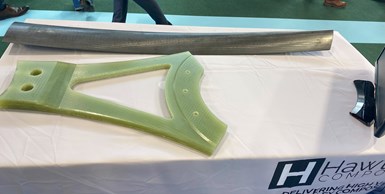
Hawthorn Composites branches out into the renewable energy market with hydroelectric turbine struts and foils. Photo Credit: CW
CEO Craig Jennings explains that in addition to the defense and aerospace markets, Hawthorn Composites has recently begun extending its expertise into new markets such as renewable energy. On display at the show were several struts and foils the company current produces for RivGen river and tidal energy systems manufactured by renewable energy company ORPC Inc. (Portland, Maine, U.S.). The components are designed by Hawthorn Composites and manufactured via vacuum-assisted RTM (VARTM) using braided preforms from partner A&P Technology (Cincinnati, Ohio, U.S.). Jennings reports that compared to the original hand-laid prepreg, Hawthorn Composites’ technology reduces manufacturing time for these components by 70%, and manufacturing cost by 30%.
The components are produced in Hawthorn Composites’ new Miamisburg, Ohio facility, completed in 2022. Jennings says that the new facility includes room for future expansion and vertical integration, including capabilities for bringing nondestructive inspection in-house.
NCFs for spar caps, natural fibers, award-winning roof beams
For non-crimp fabric (NCF) and advanced materials supplier Saertex (Saerbeck, Germany), spar caps and other components for wind turbine blades continue to be a top market, and infrastructure and transportation markets are also growing, according to Daniel Stumpp, head of global marketing.
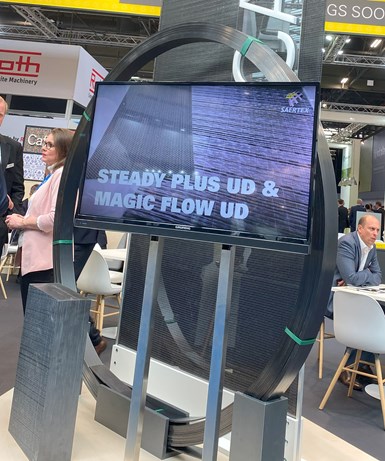
Saertex continues to supply pultruded Saerplanks spar caps for wind energy (top image) and introduces an infusable noncrimp fabric (NCF) option ideal for curved blades (bottom image). Photo Credit: CW
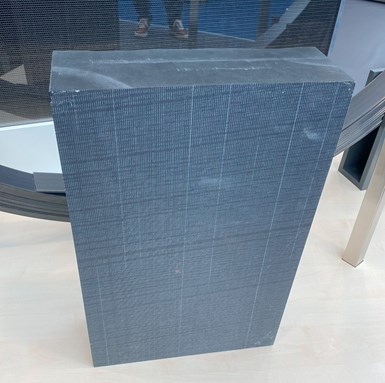
On display at JEC World this year were several new projects and products. New this year, Saertex has added a carbon fiber NCF product to its options for wind blade spar caps. In 2022, the company introduced its Saerplanks pultruded profiles for spar caps; Stumpp explains that Saerplanks are ideal for straighter blades, while the NCF version is designed for curved blades. Up to 200 individual plies of UD NCF are layered and then infused to produce each spar cap. Said to be cost-competitive with pultruded profiles, the product is said to be easily drapable without wrinkles and to contain a high fiber volume fraction (FVF).
Saertex also emphasized its capabilities in flax fiber NCFs with flax supplier partner Terre de Lin (Normany, France), and reports that it is scaling up production for its three product offerings. Stumpp adds that marine interiors are currently the largest application area for these products. Also new for the boatbuilding market this year, the company is offering an updated version of its Saerfix adhesive film, which is said to have a 10 times better hold than earlier iterations of the product without solvents or aerosols.
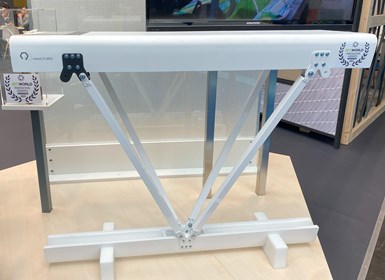
Winner of a 2023 JEC Composites Innovation Award, the top and bottom beams of a soccer stadium retractable roof are manufactured by Nanotures in part using NCFs from Saertex. Photo Credit: CW
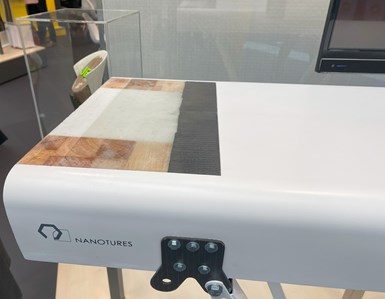
Emphasized at Saertex’s stand this year was a small-scale demonstrator version of upper and lower beams for the roof of Real Madrid’s stadium, a project that won a 2023 JEC Composites Innovation Award for the Building and Civil Engineering category. Each of the 25-meter sections, which connect to form larger 75-meter beams, are manufactured via vacuum infusion by Nanotures (Spain) from Saertex carbon fiber NCF and epoxy. The lower beams are monolithic, while the upper beams are cored with balsa and Diab (Skane, Sweden) Divinycell foam core. The overall Real Madrid stadium renovation is ongoing, but the beams were completed and installed on the stadium’s retractable roof in March 2023.
Outside of Europe, Katharina Davies, new president of Saertex USA, explains that in North America, the plant in Ciudad Juarez, Mexico, is now up and running with production for the wind industry, and the plant in Huntersville, North Carolina, is focused on growing markets in infrastructure and transportation for the NAFTA region. Alongside its technology developments, Davies says that Saertex USA is also running a workforce development program emphasizing apprenticeships and internal trainings, with a focus on diversity and inclusion.
Demonstrating large-format additive manufacturing
In and near the 3D Printing Village were a number of additive manufacturing (AM) companies on display. New to JEC World as an exhibitor this year was large-format 3D printing specialist Caracol’s (Barlassina, Italy) with an emphasis on its Heron AM integrated hardware and software system that was launched in 2022.
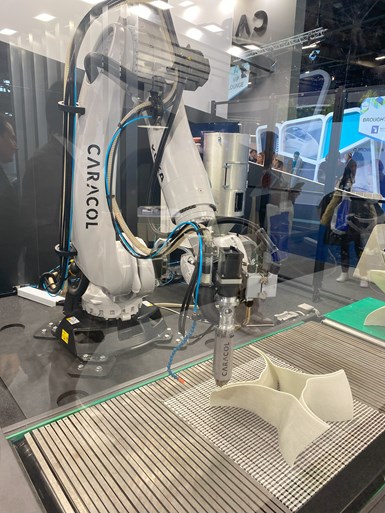
New as an exhibitor to JEC World, Caracol demonstrated its large-scale, robot-mounted composite 3D printing technology. Photo Credit: CW
Mounted on a robotic arm and controlled by Caracol software, the Heron AM system is available in several printhead sizes and is compatible with a range of thermoplastic resin pellets, reinforced with up to 30-40% glass or carbon fiber. Recycled materials can also be used, as demonstrated by an R&D demonstrator wind blade at the show, made for a research project with partner Enel Green Power (Rome, Italy) using recycled polypropylene (PP) and fiberglass.
New products on display included the High-Flow extruder head for the Heron AM system, which was launched in November 2022, for applications requiring faster lay-down speeds. A new automated print platform is also available for Heron AM systems to move the part to and from the print bed automatically.
Violetta Nespolo, chief marketing and strategy officer, reports that Caracol is continuing R&D efforts into new materials and, increasingly, recycled materials, as well as new printing technologies. The company ultimately plans to expand its operations to the U.S. as well.
Braiding technology: Flax and recycled fibers, combining braiding with UD tapes
Eurocarbon BV (Sittard, Netherlands) showcased its capabilities for producing braided preforms, as well as its braiding machines available for customers or used by EuroCarbon for R&D initiatives. Along with key application for its carbon fiber or fiberglass braided preforms in markets including sporting goods, aerospace filler noodles, orthopedic prosthetics and automotive applications, EuroCarbon emphasized at the show its capabilities in newer materials like flax, basalt or recycled fibers.
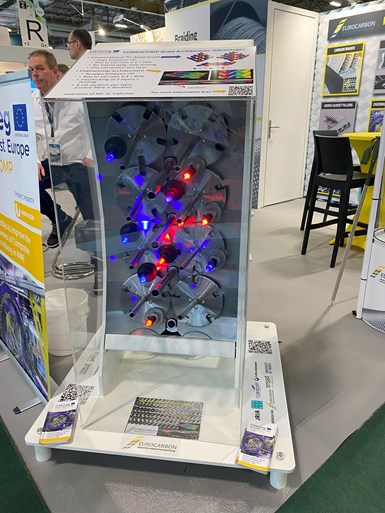
Developed for the Cobracomp consortium, EuroCarbon demonstrated a demo-sized version of its braider (using lights instead of material), which interlocks braiding with UD tape laying. Photo Credit: CW
On display at its booth was a small-scale demonstrator version of a double-radius braider EuroCarbon developed as part of the Cobracomp consortium, a 3-year project through the end of 2023 which aims to produce a higher-strength curved, carbon fiber composite propeller blade (manufactured by partner Collins Aerospace). EuroCarbon’s braiding system interlocks UD tape laying with triaxial braiding to produce a complex preform that is then infused to produce the final propeller prototype.
Graphene enhancements for space components, tanks, composite tooling
There were a number of suppliers of graphene additives for use in composites at the show. One of these was Levidian (Cambridge, U.K.), sharing a booth with Adamant Composites (Platani-Patras, Greece), a space-focused fabricator that specializes in use of graphene and other nanomaterials within composite parts. The two companies previously announced a partnership in June 2022.
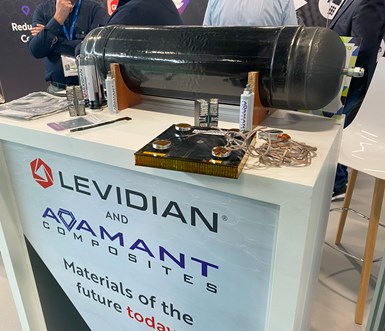
Levidian and Adamant Composites were one of many booths displaying graphene additives for enhancing composite material properties. Photo Credit: CW
Levidian offers pure graphene products in powder form or formulated as a PET masterbatch. In collaboration with Adamant Composites, Levidian’s graphene can also be integrated into intermediate products such as a spray or adhesive for use in composites manufacturing. Notably, Levidian’s graphene is formed not from graphite but methane, through the company’s Loop microwave-based process that extracts pure carbon from methane gas. The process is said to produce no CO2 emissions and is fully traceable to ensure consistent quality.
The companies’ focus has been applications that require improved thermal or multifunctional performance, such as high thermal conductivity tooling for aerospace or space parts. As an example, on display at the booth was a graphene-enhanced carbon fiber composite wing tool.
Adamant Composites also emphasized its space components including an R&D demonstrator graphene-enhanced carbon fiber composite launcher panel made for a research project with the European Space Agency (ESA), and its capabilities for producing a linerless carbon fiber composite liquid oxygen tank in collaboration with HyImpulse Technologies (Neuenstadt am Kocher, Germany).
JEC Award-winning rollover cage
Action Composites (Ried im Innkreis, Austria) specializes in the design and manufacture of carbon fiber composite components for the automotive industry, especially complex, visual components for premium vehicles such as spoilers and mirror caps. The company has production facilities in China and Vietnam and is exploring the establishment of a North American branch.
The company has recently begun broadening its offerings to more structural components, including subframe and chassis parts, coil springs and fully carbon fiber composite or hybrid aluminum-composite wheels. Action Composites’ capabilities include prepreg layup, RTM, braided preforming, SMC and compression molding.
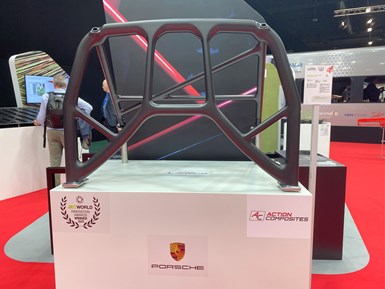
On display as one of this year’s JEC Innovation Award winners, this Porsche rollover cage was redesigned for carbon fiber composites using biomimetic principles.
Photo Credit: CW
Emphasized at the show was a rollover cage developed for Porsche, which took home a JEC Composites Innovation Award for Automotive and Road Transportation (Design Part).
Joest Hoekstra, key account manager for North America, explains that the part, which serves to protect a driver in a racing vehicle in the event of a rollover, is the first carbon fiber composite rollover cage in series production for a road legal vehicle in Europe. Developed with Porsche, the cage design was originally built in steel or titanium, then optimized for carbon fiber with Action Composites. The carbon fiber-reinforced polymer (CFRP) version boasts 10% lighter weight than titanium, and is manufactured in two steps via bladder molding and compression molding using prepreg. Critically, the part was redesigned using biomimetic/nature-inspired principles — a strategy called “Action Bionic Carbon” — to optimize the cage’s design for the weight and strength characteristics of carbon fiber composites, showing potential of CFRP in automotive safety components.
Related Content
Plant tour: Teijin Carbon America Inc., Greenwood, S.C., U.S.
In 2018, Teijin broke ground on a facility that is reportedly the largest capacity carbon fiber line currently in existence. The line has been fully functional for nearly two years and has plenty of room for expansion.
Read MoreRecycling end-of-life composite parts: New methods, markets
From infrastructure solutions to consumer products, Polish recycler Anmet and Netherlands-based researchers are developing new methods for repurposing wind turbine blades and other composite parts.
Read MorePlant tour: Joby Aviation, Marina, Calif., U.S.
As the advanced air mobility market begins to take shape, market leader Joby Aviation works to industrialize composites manufacturing for its first-generation, composites-intensive, all-electric air taxi.
Read MorePEEK vs. PEKK vs. PAEK and continuous compression molding
Suppliers of thermoplastics and carbon fiber chime in regarding PEEK vs. PEKK, and now PAEK, as well as in-situ consolidation — the supply chain for thermoplastic tape composites continues to evolve.
Read MoreRead Next
Plant tour: Daher Shap’in TechCenter and composites production plant, Saint-Aignan-de-Grandlieu, France
Co-located R&D and production advance OOA thermosets, thermoplastics, welding, recycling and digital technologies for faster processing and certification of lighter, more sustainable composites.
Read MoreAll-recycled, needle-punched nonwoven CFRP slashes carbon footprint of Formula 2 seat
Dallara and Tenowo collaborate to produce a race-ready Formula 2 seat using recycled carbon fiber, reducing CO2 emissions by 97.5% compared to virgin materials.
Read MoreDeveloping bonded composite repair for ships, offshore units
Bureau Veritas and industry partners issue guidelines and pave the way for certification via StrengthBond Offshore project.
Read More
.jpg;width=70;height=70;mode=crop)



